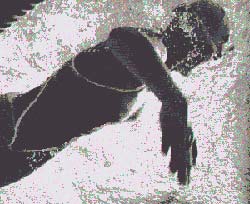Finger Placement
Open or closed? Unless you are a duck, you will most likely swim with your fingers together rather than apart. Since ducks have a heck of a lot of webbing between their 'fingers' they get a huge advantage from swimming with their fingers spread open. The increased area generated by the webbing is the equivalent of us swimming with paddles. For humans, our webbing is minimal so the advantages are slim to none.
By keeping our fingers together, we are able to generate propulsion by planing our hands through the water. Using the same physics principles that allow a plane to fly, our hands act as wings, generating lift, or for our purposes, lift and propulsion. If we swam without planing, our hands would only stroke straight back when swimming. Instead, if you pay attention, you will notice that your hands make an 'S' pattern through the water as they push backward. This is because your hands are planing rather than just pushing the water. Open fingers would not allow this to occur.
Totally closed? For many years, coaches and swimmers alike, preached that fingers should be completely closed to maximize speed. But recently, upon underwater observation of the best swimmers in the world, it was realized that these swimmers actually allowed for some space between their fingers while swimming. More precisely, they allow for some flexibility in their fingers which allow for some water to slide in between the fingers.
What this means for swimmers is that their fingers should be kept together, but not stiffly together. Too stiff hurts a swimmer's feel for the water, too loose hurts the planing effect and decreases propulsion.
Look at the underwater picture below to see an example of how most swimmers hands look while swimming. They are together and stiff, but not too stiff. And some gaps between the fingers become apparent at different parts of the stroke.
